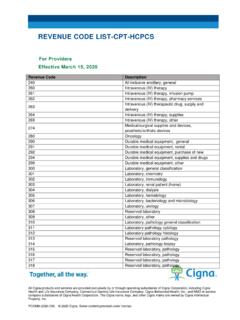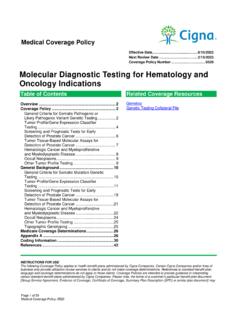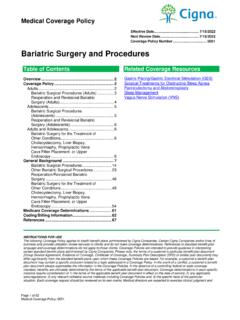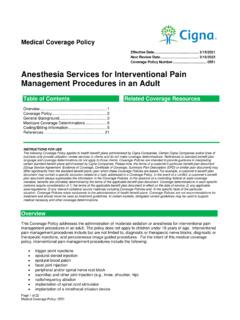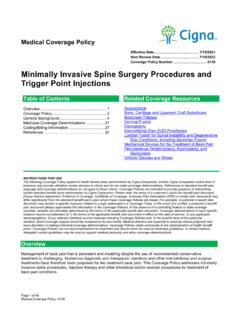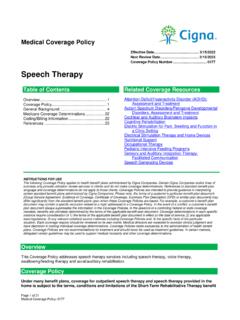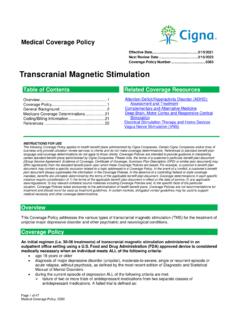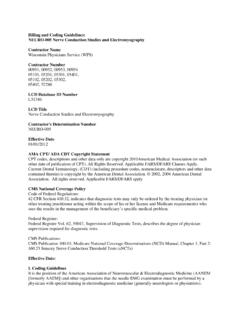Transcription of Intraoperative Monitoring - Cigna
1 Page 1 of 41 Medical Coverage Policy: 0509 Medical Coverage Policy Effective Date .. 9/15/2021 Next Review Date .. 9/15/2022 Coverage Policy Number .. 0509 Intraoperative Monitoring Table of Contents Overview .. 1 Coverage Policy .. 1 General Background .. 3 Medicare Coverage Determinations .. 9 Coding/Billing Information .. 9 References .. 34 Related Coverage Resources Electrodiagnostic Testing (EMG/NCV) (CPG 129) INSTRUCTIONS FOR USE The following Coverage Policy applies to health benefit plans administered by Cigna Companies. Certain Cigna Companies and/or lines of business only provide utilization review services to clients and do not make coverage determinations. References to standard benefit plan language and coverage determinations do not apply to those clients. Coverage Policies are intended to provide guidance in interpreting certain standard benefit plans administered by Cigna Companies. Please note, the terms of a customer s particular benefit plan document [Group Service Agreement, Evidence of Coverage, Certificate of Coverage, Summary Plan Description (SPD) or similar plan document] may differ significantly from the standard benefit plans upon which these Coverage Policies are based.
2 For example, a customer s benefit plan document may contain a specific exclusion related to a topic addressed in a Coverage Policy. In the event of a conflict, a customer s benefit plan document always supersedes the information in the Coverage Policies. In the absence of a controlling federal or state coverage mandate, benefits are ultimately determined by the terms of the applicable benefit plan document. Coverage determinations in each specific instance require consideration of 1) the terms of the applicable benefit plan document in effect on the date of service; 2) any applicable laws/regulations; 3) any relevant collateral source materials including Coverage Policies and; 4) the specific facts of the particular situation. Each coverage request should be reviewed on its own merits. Medical directors are expected to exercise clinical judgment and have discretion in making individual coverage determinations. Coverage Policies relate exclusively to the administration of health benefit plans.
3 Coverage Policies are not recommendations for treatment and should never be used as treatment guidelines. In certain markets, delegated vendor guidelines may be used to support medical necessity and other coverage determinations. Overview This Coverage Policy addresses the performance of Intraoperative Monitoring (IOM). Intraoperative Monitoring (IOM) is an umbrella term used to describe a variety of electrodiagnostic tests used to monitor the integrity of neural pathways during surgical procedures when there may be risk of damage to the brain, spinal cord or nerve. Coverage Policy Continuous Intraoperative Monitoring (CPT Codes: 95940, 95941; HCPCS Code G0453) Continuous Intraoperative neurophysiologic Monitoring (IOM) is considered medically necessary when ALL of the following criteria are met: IOM is performed by either a licensed physician trained in clinical neurophysiology ( , neurologist, physiatrist) or a trained technologist who is practicing within the scope of his/her state license /certification as defined by state law or appropriate authorities and is working under the direct supervision of a physician trained in neurophysiology, and is not the operating surgeon or anesthesiologist.
4 Page 2 of 41 Medical Coverage Policy: 0509 IOM is interpreted by a licensed physician trained in clinical neurophysiology, other than the operating surgeon or anesthesiologist, who is either physically in attendance in the operating suite or present by means of a real-time remote mechanism for all electroneurodiagnostic (END) Monitoring situations and is immediately available to interpret the recording and advise the surgeon. Monitoring is conducted and interpreted real-time (either on-site or at a remote location) and continuously communicated to the surgical team. There is significant risk of brain, spinal cord, cranial nerve, or major peripheral nerve injury during a surgical procedure, such as the following: Monitoring of a cranial nerve during head and/or neck surgery ( , resection of skull base tumor, resection of tumor involving a cranial nerve, cavernous sinus tumor, neck dissection, epileptogenic brain tumor/tissue resection) Monitoring of recurrent laryngeal nerve function during high-risk thyroid surgery ( , complete resection of a lobe of the thyroid, removal of the entire gland, malignancy, or following a prior thyroid surgery where there is scar tissue surrounding the laryngeal nerve) risk for cerebral ischemia ( , surgery of the aortic arch, thoracic aorta, internal carotid artery endarterectomy, intracranial arteriovenous malformation, bronchial artery arteriovenous malformation or tumor, cerebral aneurysm) Monitoring of facial nerve function during surgery ( , acoustic neuroma, microvascular decompression of the facial nerve for hemifacial spasm, parotid tumor resection, neurotologic/otologic procedures)
5 Monitoring of spinal cord function during a spinal procedure when there is significant risk of spinal cord injury due to mechanical spinal distraction, correction of deformity, spinal cord tumor, myelotomy or spinal fracture (including reduction maneuvers) resulting in cord compression brachial or lumbar plexus surgery the planned surgery poses a high risk of significant damage to an essential nervous system structure ( , neuroma of peripheral nerve, leg lengthening procedure when there is traction on the sciatic nerve) Please note: Train of four Monitoring is considered integral to Intraoperative Monitoring and/or administration of anesthesia. Similarly, stimulus-triggered EMG is considered integral to Intraoperative Monitoring and/or the baseline surgical procedure when performed to aid placement of pedicle /facet screws. The following are each considered experimental, investigational, or unproven: Intraoperative neurophysiologic Monitoring of visual evoked potentials Intraoperative neurophysiologic Monitoring of motor evoked potentials using transcranial magnetic stimulation Intraoperative neurophysiologic Monitoring (IOM) is considered not medically necessary for ANY other indication, including the following.
6 During lumbar surgery performed below spinal column level L1 - L2 during cervical spine surgery ( , anterior and/or posterior cervical fusion, discectomy or laminectomy) in the absence of a vertebral or intraspinal tumor, traumatic spine/spinal cord injury including subluxation/dislocation, deformity correction, or surgery of the spinal cord during epidural injections during sacroiliac joint injections during radiofrequency ablation/denervation procedures during placement of spinal cord or dorsal root ganglion stimulator during placement of an intrathecal pain pump Baseline Electrodiagnostic Studies Page 3 of 41 Medical Coverage Policy: 0509 Baseline electrodiagnostic studies prior to surgery are separately reportable, however each baseline study is limited to once per operative session. The necessary baseline electrodiagnostic testing modality is determined by the location and type of surgery and may include any of the following modalities, alone or in combination, (this list may not be all-inclusive): Somatosensory evoked potentials (SSEP) Auditory brainstem evoked responses (ABR)/Brainstem auditory evoked potentials (BAEP) Transcranial electrical motor evoked potentials (tcMEP) Free running electromyography (EMG) Electroencephalography (EEG) The above electrodiagnostic studies, performed alone or in combination, are considered medically necessary for the pre-operative evaluation of neural integrity when medical necessity criteria have been met for continuous Intraoperative neurophysiologic Monitoring .
7 Electrodiagnostic studies for preoperative evaluation of neural integrity is considered not medically necessary when medical necessity criteria for continuous Intraoperative neurophysiologic Monitoring have not been met. General Background Intraoperative Monitoring (IOM) employs the use of electrodiagnostic modalities to record electrical signals produced by the nervous system in response to a stimuli; the Intraoperative Monitoring reflects the time spent during ongoing, concurrent, real time electrodiagnostic testing performed throughout the surgery. The goal of Intraoperative Monitoring is to detect response changes due to surgery, to diminish the risk of neurologic injury, improve patient safety and subsequent surgical outcomes. Intraoperative Monitoring Modalities Intraoperative Monitoring modalities may include, but are not limited to the following neurophysiological techniques, alone or in combination: Sensory Evoked potentials ( , somatosensory [SSEP], auditory brainstem evoked responses [ABR], visual evoked potentials [VEP]) Motor evoked potentials (MEP) Electromyography (EMG), free-running or stimulus-triggered Electroencephalogram (EEG) Multiple modalities are typically used for IOM to overcome the limitations of individual Monitoring .
8 Selection of the approach used is dependent upon the type of surgery and the degree of risk. Somatosensory Evoked Potentials (SSEP): SSEPs are electrical waves generated by the response of sensory neurons to stimuli, evaluate primarily posterior spinal cord function, and are a standard technique for IOM. SSEPs are generally combined with EMG Monitoring to allow for an Intraoperative evaluation that is both sensitive to damage and specific with regards to predicting outcome. SSEPs have low sensitivity to predict damage but high specificity whereas EMG has high sensitivity to nerve root function but low specificity in terms of predicting a persistent neurological deficit (Gunnarsson, et al., 2004). IOM of the cervical spinal cord involves stimulation of the ulnar or median nerve, IOM of the thoracolumbar spinal cord involves stimulation of the posterior tibial or common peroneal nerve (American Clinical Neurophysiology Society [ACS], 2009).
9 Auditory Brainstem Evoked Responses (ABR): ABR Monitoring , also referred to as brainstem auditory evoked potentials (BAEP) measures brainwave activity and is recorded in response to an auditory stimulus from electrodes placed on the scalp. The electrodes pick up the brain s responses to the sounds and record them. Visual-Evoked Potentials (VEPs): Visual-evoked potentials (VEPs) are used to track visual stimuli from the retina to the occipital cortex and have been indicated during surgical procedures involving lesions near the optic nerve, however this technique is still being investigated and clinical utility has not been established. Variables Page 4 of 41 Medical Coverage Policy: 0509 such as type of patterned stimuli, temperature, and anesthesia effects cannot be controlled in the operative setting. Motor Evoked Potentials (MEP): MEPs are recorded over muscles or the spinal cord, and evaluate anterior spinal cord and motor pathways.
10 The technique involves stimulation to the motor cortex using electromagnetic energy by way either trans-cranial electrical stimulation or pulsed magnetic stimulation via a coil placed over the head to stimulate motor neurons. SSEP and transcranial electrical MEPs are often performed in combination throughout surgery and are considered complimentary multimodal procedures; MEPs in combination with SSEPs appear to improve the accuracy of spinal cord Monitoring (Liem, 2016). While transcranial electrical stimulation devices have been approved by the FDA devices for transcranial magnetic stimulation are not yet FDA approved. Electromyography (EMG): EMG evaluation during surgery, a test that evaluates electrical activity of the muscle and an associated nerve, may be performed as free-run Monitoring of EMG activity or as a stimulus-triggered EMG from anatomically appropriate muscles in order to detect injury to nerve roots during surgery. Free-run EMG is defined as continuous Monitoring performed throughout the surgery.
